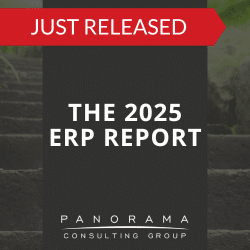Imagine a global manufacturing company grappling with a major delivery delay due to conflicting inventory data, or a healthcare provider unable to access critical patient information because their records are stored in fragmented databases.
In a business environment that demands agility and seamless information flow, the consequences of poor system integration are substantial. Disconnected systems create data silos, increase manual workloads, and hinder decision-making.
Today, we will talk about the impact of poor system integration by exploring both immediate and long-term financial and operational consequences. We’ll also provide strategic recommendations to help you mitigate these risks, ensuring alignment across technology, people, and processes.
A Failed Payroll System Implementation
Panorama’s Expert Witness team was retained to provide a forensic analysis and written report to the court regarding the failed implementation of a major software developer’s ERP/payroll system.
Short-Term Consequences of Poor System Integration
1. Increased Operational Costs
One of the most immediate impacts of disconnected enterprise systems is a rise in operational costs. When systems don’t communicate effectively, employees must resort to manual processes to bridge the gaps.
This reliance on manual data entry and redundant workarounds not only consumes time but also drives up labor costs.
For example, disconnected ERP systems, particularly between supply chain and inventory management, can lead to inaccurate inventory data and higher operational costs.
Increased operational costs might include:
- Inefficiency in Data Processing: Employees often find themselves manually transferring data between systems, increasing the risk of human error. Rectifying this incurs further expenses.
- Redundant Workflows: Separate teams may be verifying the same data, leading to duplicated tasks and an unnecessary allocation of resources.
- System Maintenance Costs: Maintaining disparate systems with unique support requirements strains IT budgets, as organizations may need specialized support staff for each system.
Expert Tip
If you’re struggling with supply chain management issues, implementing SCM software that integrates seamlessly with ERP and CRM systems can eliminate redundant data entries and ensure accurate inventory tracking.
2. Delayed Decision-Making
Siloed systems limit real-time visibility across departments. Without a single source of truth, executives and managers struggle to access reliable information, slowing down decision-making.
Impacts include:
- Inconsistent Reporting: Data inconsistencies between finance, sales, and supply chain systems lead to conflicting reports, making it difficult to make informed decisions.
- Time Lag in Data Retrieval: Manually pulling data from different systems is time-consuming and prone to errors, making businesses slow to respond to changing market dynamics.
- Reactive Management: Due to poor system integration, organizations often end up addressing issues reactively rather than proactively, impairing their ability to capitalize on opportunities or mitigate risks.
3. Customer Service Disruptions
For example, when customer service representatives lack access to unified data, it results in inconsistent communication and delays in issue resolution.
Other customer service disruption issues include:
- Inaccurate Order and Inventory Information: If sales, customer service, and inventory systems are not integrated, representatives may provide incorrect information about product availability or delivery timelines.
- Prolonged Response Times: Without a 360-degree view of the customer, service teams spend excessive time navigating through different systems to retrieve basic information.
- Inconsistent Cross-Channel Experience: Siloed systems make it difficult to provide a consistent experience across different channels (e.g., in-store and online). Customers expect smooth transitions between platforms, and any disjointed experience can negatively impact their perception of your brand.
4. Revenue Leakage
Disconnected systems can directly impact an organization’s bottom line by creating gaps that lead to revenue leakage, manifesting in various forms, from misinvoicing to lost sales opportunities.
Revenue issues include:
- Billing Errors: Poor integration between CRM and financial systems often results in delayed or inaccurate invoicing, increasing disputes and affecting cash flow.
- Missed Sales Opportunities: Sales teams operating in a fragmented environment lack visibility into customer histories, resulting in missed opportunities for cross-selling and upselling.
- Inventory Overstocking and Stockouts: With separate inventory and sales systems, businesses may overstock slow-moving products or experience stockouts of high-demand items, resulting in lost revenue and increased holding costs.
Long-Term Financial and Operational Consequences
1. Strategic Misalignment and Poor Organizational Agility
Impacts include:
- Inability to Scale Operations: As organizations grow, poor integration makes it challenging to scale systems and processes. This misalignment can stunt growth and reduce competitive advantage.
- Lack of Business Agility: Enterprises facing constant system compatibility issues are slow to implement new business models or enter new markets, making it difficult to respond to customer demands or disruptions.
- Loss of Competitive Edge: Many of your competitors are likely using fully integrated systems, so they may have an advantage over you: They can leverage real-time data to optimize their operations and enhance customer experiences.
2. Increased Risk Exposure
The specific consequences include:
- Regulatory Compliance Failures: Industries such as finance and healthcare are heavily regulated, requiring precise and unified data management. Poor integration can result in incomplete audit trails, making it difficult to demonstrate compliance.
- Data Security Vulnerabilities: Multiple, poorly integrated systems increase the number of potential entry points for cyberattacks. Each system may have its own security protocol, creating inconsistencies that malicious actors can exploit.
- Operational Disruptions: When a critical system goes offline or is compromised, other systems may not have the resilience to operate independently.Why? Disconnected systems actually still have interdependencies (i.e., periodic data feeds workflow triggers, etc.).
3. Stagnant Innovation
Issues include:
- Barrier to Innovation: Integrated systems provide a foundation for experimenting with new technologies like AI, machine learning, and automation. Without integration, these innovations are difficult to implement.
- Inability to Leverage Advanced Analytics: A fragmented system architecture makes data aggregation complex and hampers the use of advanced analytics and business intelligence tools. Without unified data, organizations lack insights that could drive strategic initiatives or foster new product development.
- Loss of Institutional Flexibility: An overreliance on patchwork solutions prevents organizations from developing adaptable systems that can be reconfigured to meet changing needs.
4. Erosion of Brand Reputation and Market Position
Issues include:
- Inconsistent Product Quality: Poorly integrated systems can lead to inconsistent product quality due to misaligned production processes and communication breakdowns between manufacturing and quality control. These inconsistencies damage brand reputation over time, as customers experience varying levels of quality.
- Difficulty Retaining High-Value Clients: Poor integration can lead to service disruptions that damage relationships with key accounts, making it difficult to retain high-value clients.
- Declining Market Position: As a company’s reputation suffers, it loses its ability to attract new customers and top-tier talent, resulting in a downward spiral that can be difficult to reverse.
Strategic Recommendations to Address System Integration Challenges
Addressing the consequences of poor system integration requires a strategic approach that aligns technology with broader business objectives.
1. Invest in Enterprise-Wide Integration
Considerations:
- Choose Scalable Integration Platforms: Select solutions that can scale with your business growth, accommodating new systems and evolving requirements.
- Prioritize Cloud-Based Integration: Cloud-based platforms offer flexibility, quicker deployment, and lower upfront costs compared to on-premises solutions.
Expert Tip
Another option is replacing most of your current systems with a fully-integrated ERP solution. Many of the top ERP systems are ideal for this.
2. Adopt a Comprehensive Data Management Strategy
Considerations:
- Implement Data Governance: Prioritize practices that ensure data consistency across all integrated systems.
- Leverage Master Data Management (MDM): Implement MDM to unify disparate data sources, creating a central repository for critical information.
3. Strengthen Change Management and Training Programs
Considerations:
- Engage Stakeholders Early: Involve key stakeholders from different departments during the planning phase to ensure cross-functional needs are met.
- Provide Role-Based Training: Offer customized training sessions tailored to each department’s specific use cases.
4. Focus on Long-Term Integration Planning
Considerations:
- Develop a Roadmap for Future Integrations: Establish a multi-year roadmap that aligns integration efforts with business goals.
- Regularly Audit System Performance: Periodically evaluate system performance and integration points to identify gaps and refine strategies.
More Than Technical Inconvenience
The consequences of poor system integration extend far beyond technical inconvenience, and short-term impacts can evolve into severe long-term consequences.
If your organization has faced recurring integration issues or failed software implementations, engaging a software failure expert during the planning phase can provide critical insights. These experts can identify potential integration pitfalls early, ensuring a more successful long-term integration strategy.
Reach out to our ERP consultants to learn how to lay the groundwork for sustained growth and innovation in today’s interconnected business landscape. Click below for a free ERP consultation.














